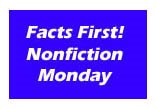Chickens are fascinating animals and with the resurgence of interest in keeping them, more children have or know someone who has a few chickens. Having spent last week watching my niece’s and nephew’s hilarious home videos of farmyard chickens walking backwards (don’t ask), I just knew I had to share some children’s books about these engaging birds.
Nonfiction
Our first book is A Chicken Followed Me Home!: Questions and Answers about a Familiar Fowl by Robin Page, which was nominated for a 2015 Cybils award in the Elementary/Middle Grade Nonfiction category.
Written in a lively question-and-answer format, the text explains such basics as what a chicken eats, how to tell a hen from a rooster, how a chick gets out of its shell, etc. The framing story of a chicken following someone home adds imagination and some light humor.
The back matter contains two pages of even more pertinent questions about chickens, including where did the first chicken come from, how fast can a chicken run, and what is the largest breed of chicken. Do you know the answers?
Robin Page did the colorful, highly-textured illustrations digitally. They have a collage feel reminiscent of those done by her children’s book illustrator husband, Steve Jenkins.
A Chicken Followed Me Home would be useful for a child learning about their first chicken or one writing a report about chickens. It also just might encourage someone to try keeping a few chickens of their own.
Age Range: 5 – 10 years
Publisher: Beach Lane Books (May 19, 2015)
ISBN-10: 1481410288
ISBN-13: 978-1481410281
When I was a child, our youth group used to visit the Cornell University College of Veterinary Medicine open house each spring (highly recommended if you live nearby!) Our favorite was always the chicken development exhibit because it featured chicks hatching. The new chicks were so lively and adorable, you could spend hours watching them.
When your children are ready to learn more about the “birds and the bees,” learning about chicken reproduction and development can be a reasonable first step. Following are two books that take a scientific approach and include diagrams of a hen’s reproductive tract.
The Egg by Rene Mettler is part of the My First Discoveries series known for its innovative layered see-through and lift-a-page illustrations.
In this case, children get a close up inside look at both a egg inside a hen and what happens inside an egg as a chick develops. Most of the book is devoted to chickens, but other animals that lay eggs are also mentioned in the back. Finally, it asks what kinds of eggs you like to eat and shows eggs as food, including as a humorous touch, a chocolate Easter egg.
Although marketed for preschoolers, the book would also be appropriate for older children eager to learn about the topic.
Age Range: 3 – 5 years
Publisher: Moonlight Publishing; Expanded edition (August 1, 2012)
ISBN-10: 1851033807
ISBN-13: 978-1851033805
Where Do Chicks Come From? by Amy E. Sklansky and illustrated by Pam Paparone is part of the quality series Let’s-Read-and-Find-Out Science.
 Marketed for a slightly older age range, this book covers the same material as the one above, but with more traditional illustrations. It reveals the life cycle of the chicken in an organized, logical way.
Marketed for a slightly older age range, this book covers the same material as the one above, but with more traditional illustrations. It reveals the life cycle of the chicken in an organized, logical way.
Is your child ready for vocabulary words like “albumen” and “fertilization”? Where Do Chicks Come From? is an “eggsceptional” choice for curious young readers!
Age Range: 4 – 8 years
Publisher: HarperCollins (February 1, 2005)
ISBN-10: 9780064452120
ISBN-13: 978-0064452120
Middle Grade Fiction
How did a middle grade fiction book end up on a list for Nonfiction Monday? It turns out this imaginative work also slips in a lot of facts about chickens.
Unusual Chickens for the Exceptional Poultry Farmer by Kelly Jones and illustrated by Katie Kath is an imaginative and surprising story told in letters (an epistolary novel).
Sophie Brown and her family have just moved to her Great-Uncle Jim’s farm after his death. Her dad has lost his job and her mom is struggling to support the family by writing articles. Sophie has her own problems feeling isolated in this new place and starts writing letters to her deceased grandmother, as well as others, as a way of coping. Now, if she could just figure out the mystery of the chickens, who seem to have superpowers.
Writing a novel as a series of letters poses certain challenges and it requires the reader do a certain amount of filling in of gaps. Many readers are likely to enjoy the extra work and appreciate the humorous bits, but others might be put off by the changes in tone and general quirkiness. Serious nonfiction types might want to skim to the “Beginner’s Correspondence Course in Proper Care and Housing of Poultry: Chicken Edition” lesson sections, as well as the sidebars about the different breeds of chickens.
Unusual Chickens for the Exceptional Poultry Farmer is an unusual book. For the right reader, it will be a treasure.
Age Range: 8 – 12 years
Hardcover: 224 pages
Publisher: Knopf Books for Young Readers (May 12, 2015)
ISBN-10: 038575552X
ISBN-13: 978-0385755528
Question whether kids and chickens are a good fit? Check out this charming video of a young girl interacting with her pet chickens.
Disclosure: These books were either personal copies or came from the library. I am an affiliate with Amazon so I can provide you with cover images and links to more information about books and products. As you probably are aware, if you click through the highlighted title link and purchase a product, I will receive a very small commission, at no extra cost to you. Any proceeds help defray the costs of hosting and maintaining this website.

Looking for more children’s nonfiction books? Try the Nonfiction Monday blog.












